2023届高考英语语法复习时态语态复习 课件 (35张ppt)
文档属性
| 名称 | 2023届高考英语语法复习时态语态复习 课件 (35张ppt) |  | |
| 格式 | pptx | ||
| 文件大小 | 1.2MB | ||
| 资源类型 | 教案 | ||
| 版本资源 | 通用版 | ||
| 科目 | 英语 | ||
| 更新时间 | 2022-11-02 22:18:36 | ||
图片预览

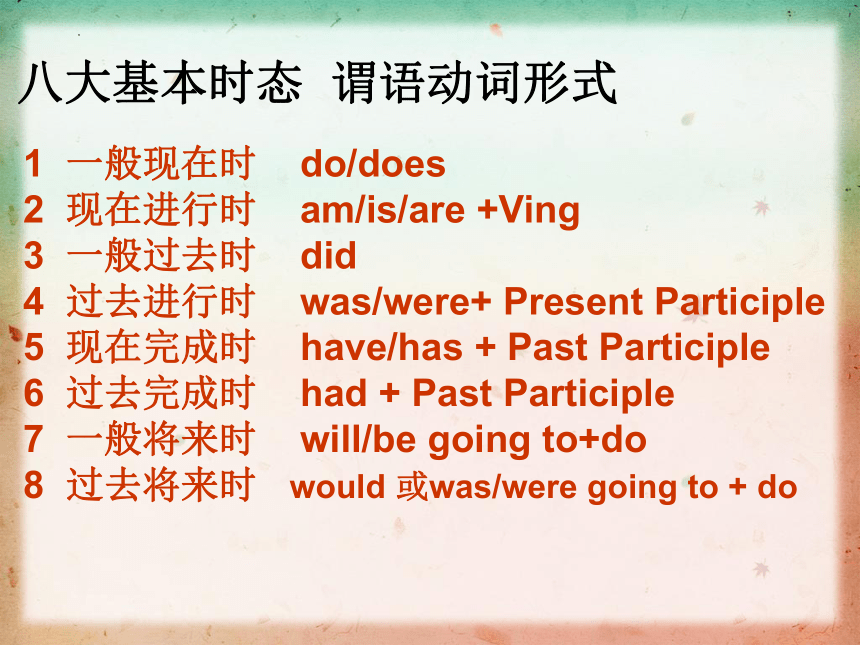
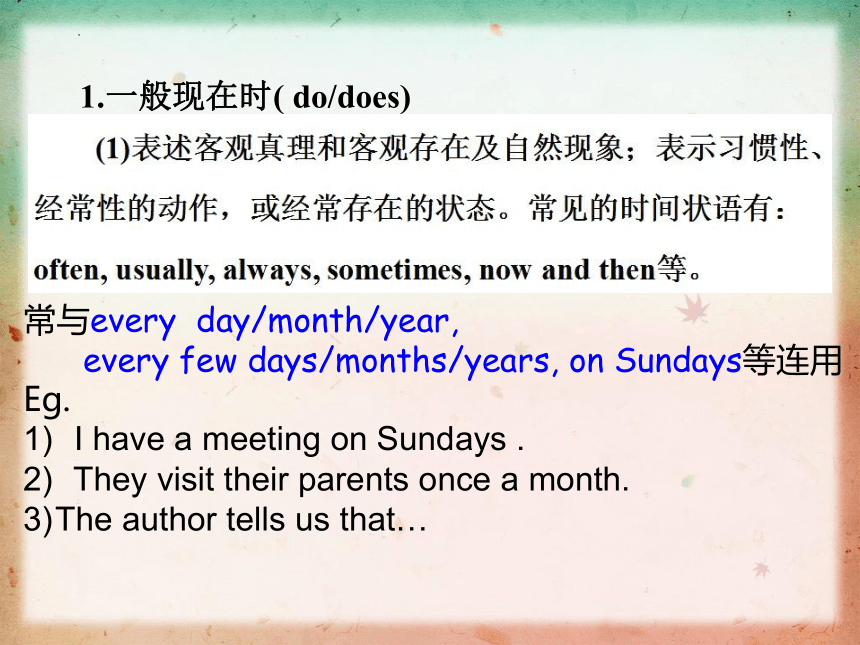
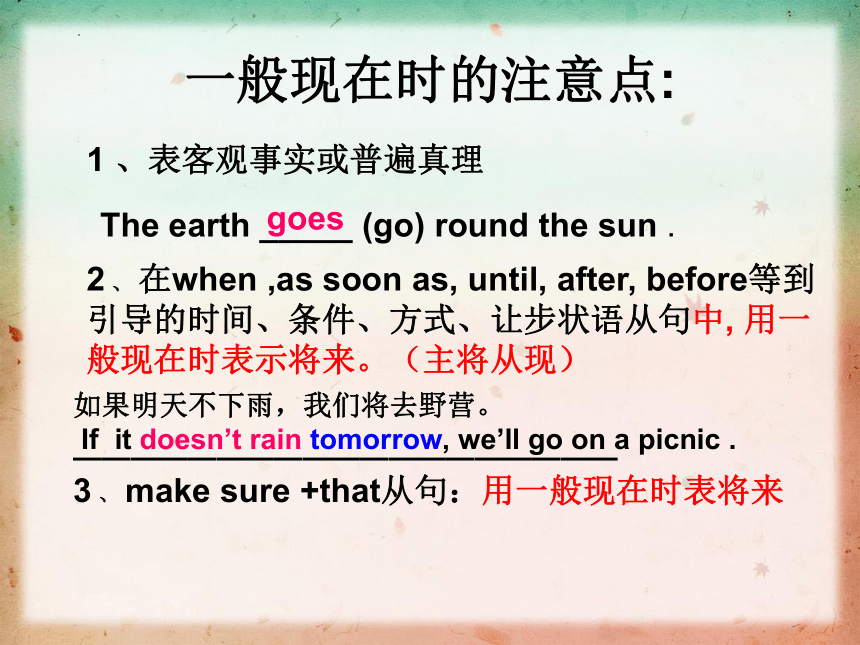
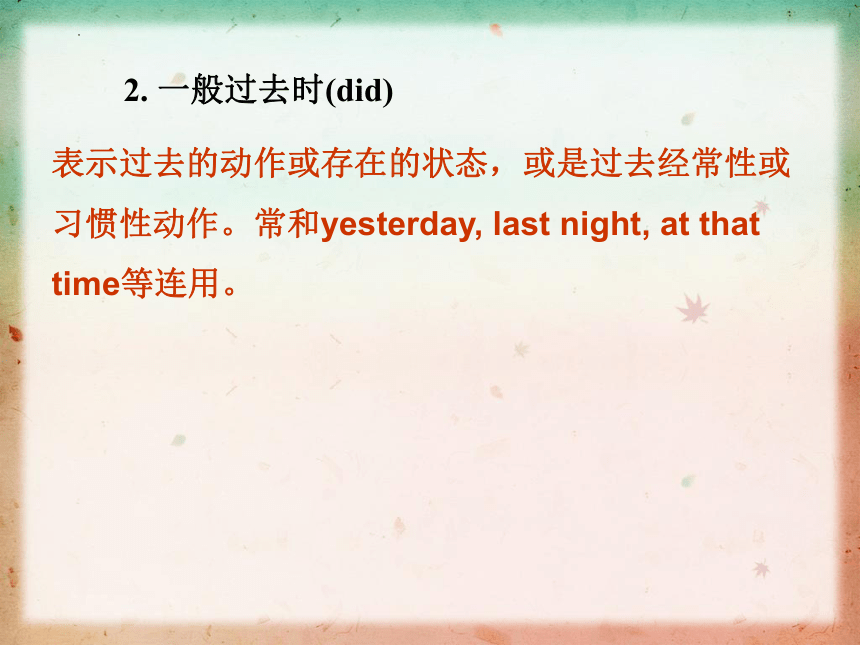
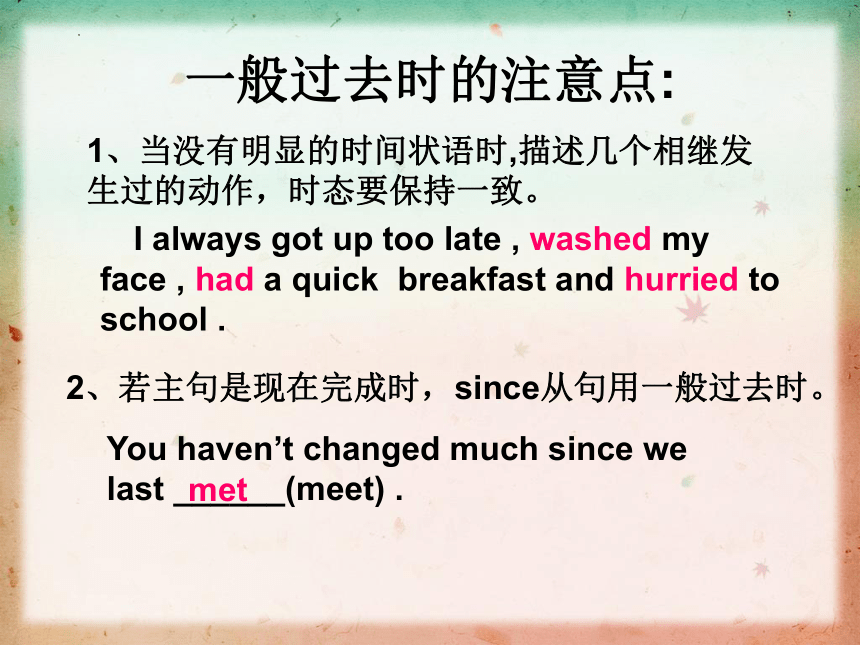



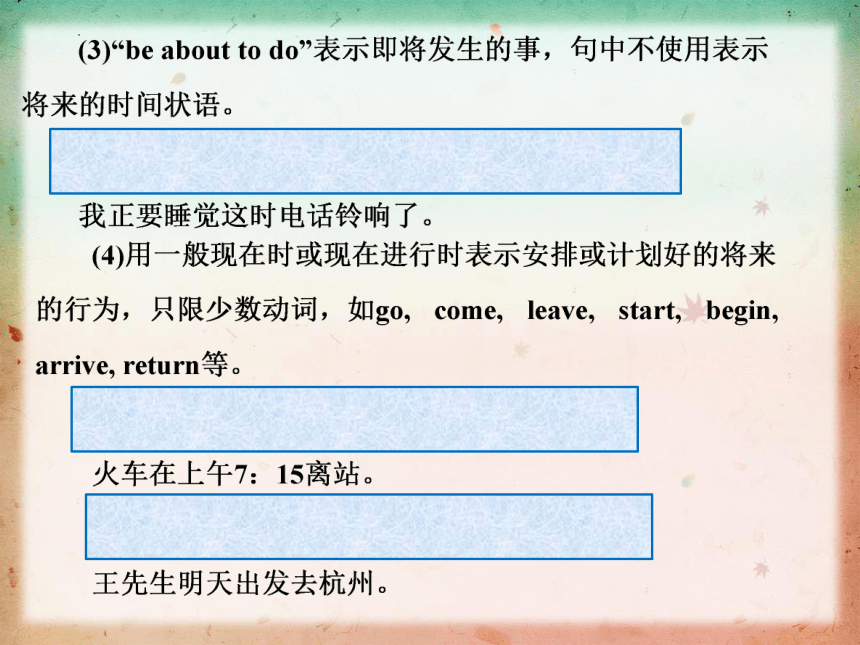

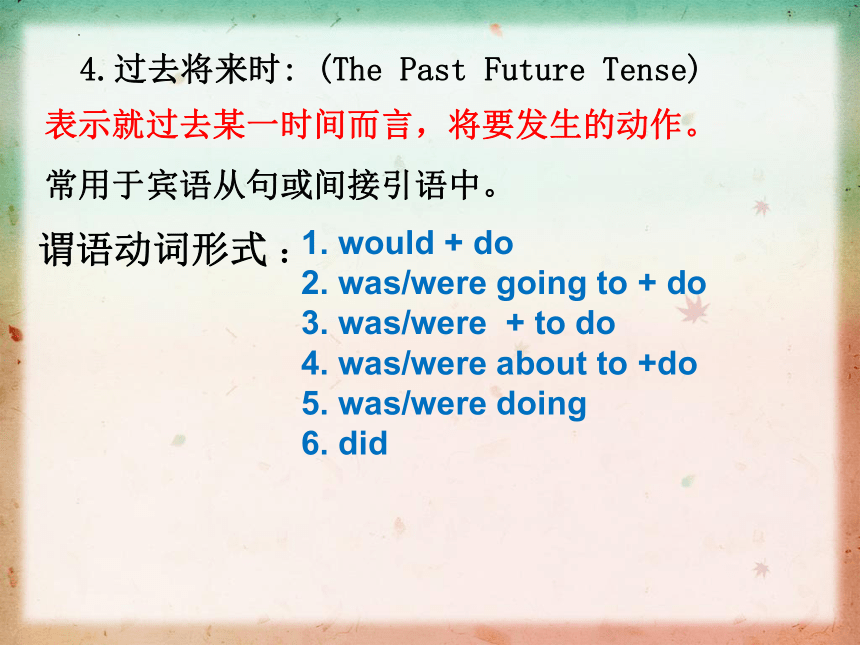
文档简介
(共35张PPT)
英语时态与语态
八大基本时态 谓语动词形式
1 一般现在时 do/does
2 现在进行时 am/is/are +Ving
3 一般过去时 did
4 过去进行时 was/were+ Present Participle
5 现在完成时 have/has + Past Participle
6 过去完成时 had + Past Participle
7 一般将来时 will/be going to+do
8 过去将来时 would 或was/were going to + do
1.一般现在时( do/does)
常与every day/month/year,
every few days/months/years, on Sundays等连用
Eg.
I have a meeting on Sundays .
They visit their parents once a month.
The author tells us that…
一般现在时的注意点:
1 、表客观事实或普遍真理
The earth _____ (go) round the sun .
2 、 在when ,as soon as, until, after, before等到引导的时间、条件、方式、让步状语从句中, 用一般现在时表示将来。(主将从现)
If it doesn’t rain tomorrow, we’ll go on a picnic .
goes
如果明天不下雨,我们将去野营。
———————————————————
3 、 make sure +that从句:用一般现在时表将来
2. 一般过去时(did)
表示过去的动作或存在的状态,或是过去经常性或习惯性动作。常和yesterday, last night, at that time等连用。
一般过去时的注意点:
1、当没有明显的时间状语时,描述几个相继发生过的动作,时态要保持一致。
I always got up too late , washed my face , had a quick breakfast and hurried to school .
2、若主句是现在完成时,since从句用一般过去时。
You haven’t changed much since we last ______(meet) .
met
常用时间状语 :
谓语动词形式 :
表示将来某个时间要发生的动作或存在的状态
tomorrow, in three days,this…, next…, soon, in the (near) future…
1. will/shall + do
2. am/is/are going to + do
3. am/is/are + to do
4. am/is/are about to +do
5. am/is/are doing
6. do/does
3.一般将来时(The Simple Future Tense)
will /shall 表示未事先思考或为计划过的意图
如:It will be Christmas soon .
(很快就圣诞节了)
注意:祈使句+and/or +句子
Work hard or you will fail.
Work hard and you will succeed.
work hard v.努力工作
hard work n.艰辛的工作
hard-working adj.勤奋的
一般将来时的注意点:
谓语动词形式 :
4.过去将来时: (The Past Future Tense)
表示就过去某一时间而言,将要发生的动作。
常用于宾语从句或间接引语中。
1. would + do
2. was/were going to + do
3. was/were + to do
4. was/were about to +do
5. was/were doing
6. did
5. 现在进行时态( am/is/are +doing)
现在进行时的注意点:
2.表达状态、感 情和感觉的动词不能用进行时。 如:中know, be, want, think, see, hear, like, hope, love, have
1.在表达时,切记不要忘了be 动词。
am/is/are + doing
6. 将来进行时(will be doing)
表示将来某一时刻正在进行的动作。
7. 过去进行时(was/were +doing)
(3)表示委婉语气。
过去进行时的注意点:
在when , while引导的时间状语从句中, 表示主从句中两个动作同时发生时, 用过去进行时表示
When my father got home, I _____ a letter to my friend.
write B. am writing
C. wrote D. was writing
较长的动作
8. 现在完成时(have/has + done)
8. 现在完成时(have/has + done)
8. 现在完成时(have/has + done)
8. 现在完成时(have/has + done)
瞬间性动词和持续性动词
*常见瞬间性动词:
buy borrow arrive put on
marry leave join die
come go begin
现在完成时的注意点:
1. have been to , have been in 和 have gone to 的区别
1).Tom ____never____ to America.
2).---- Is Tina at home
---- Sorry, she ___________ Shanxi, and she ________there for three days.
has been
has gone to
has been
2.常见搭配还有:
in the last few years, for many years
译下列句子:
3、这本书他买了一年了
4、 这本书他借了三天了。
5、我们离开广州六年了。
He has bought this book for a year .
He has had this book for a year .
He has borrowed the pen for three days .
He has kept the book for 3 days .
We have left Guangzhou for 6 years .
We have been away from Guangzhou for 6 years .
×
×
×
瞬间性动词不能跟表示一段时间的状语连用, 必须转变成持续性动词
易错点
1) 主句(现在完成时)+since 从句(一般过去时).
2)主句(过去完成时)+since 从句(过去完成时).
3)It is /has been+时间段+since+延续性动词的一般过去时“自从不做某事以来多长时间了。”
4)It is /has been+时间段+since+非延续性动词的一般过去时 “自从做某事以来多长时间了。”
9.过去完成时: (had done)
常用时间状语 :
by +过去的时间点,如by the end of last year;由when, before, after, by the time 等引导的状语丛句中,表示主句的动作发生在从句之前。
过去完成时的注意点:
用于宾词从句中,当主句的谓语动词是一般过去时时,一定要注意宾语从句中的时态变化。
He said that he _________the film many times.
had seen
10.现在完成进行时: (have/has been doing)
11.将来完成时: (will have done)
Summary:
一般现在时:is/am/are ; do; does; V-s/es
一般过去时:was/were; did; V-ed.
一般将来时:will + V. ; Is/am/are + V.
一般过去将来时:would + V.; was/were going to + V.
现在进行时:is/am/are + V-ing
过去进行时:was/were + V-ing
将来进行时:will be + V-ing
过去将来进行时:would be +V-ing
现在完成时:has/have + V-ed
过去完成时:had + V-ed
将来完成时:will have + V-ed
过去将来完成时:would have + V-ed
现在完成进行时:has/have been + V-ing
过去完成进行时:had been + V-ing
将来完成进行时:will have been + V-ing
英语时态与语态
八大基本时态 谓语动词形式
1 一般现在时 do/does
2 现在进行时 am/is/are +Ving
3 一般过去时 did
4 过去进行时 was/were+ Present Participle
5 现在完成时 have/has + Past Participle
6 过去完成时 had + Past Participle
7 一般将来时 will/be going to+do
8 过去将来时 would 或was/were going to + do
1.一般现在时( do/does)
常与every day/month/year,
every few days/months/years, on Sundays等连用
Eg.
I have a meeting on Sundays .
They visit their parents once a month.
The author tells us that…
一般现在时的注意点:
1 、表客观事实或普遍真理
The earth _____ (go) round the sun .
2 、 在when ,as soon as, until, after, before等到引导的时间、条件、方式、让步状语从句中, 用一般现在时表示将来。(主将从现)
If it doesn’t rain tomorrow, we’ll go on a picnic .
goes
如果明天不下雨,我们将去野营。
———————————————————
3 、 make sure +that从句:用一般现在时表将来
2. 一般过去时(did)
表示过去的动作或存在的状态,或是过去经常性或习惯性动作。常和yesterday, last night, at that time等连用。
一般过去时的注意点:
1、当没有明显的时间状语时,描述几个相继发生过的动作,时态要保持一致。
I always got up too late , washed my face , had a quick breakfast and hurried to school .
2、若主句是现在完成时,since从句用一般过去时。
You haven’t changed much since we last ______(meet) .
met
常用时间状语 :
谓语动词形式 :
表示将来某个时间要发生的动作或存在的状态
tomorrow, in three days,this…, next…, soon, in the (near) future…
1. will/shall + do
2. am/is/are going to + do
3. am/is/are + to do
4. am/is/are about to +do
5. am/is/are doing
6. do/does
3.一般将来时(The Simple Future Tense)
will /shall 表示未事先思考或为计划过的意图
如:It will be Christmas soon .
(很快就圣诞节了)
注意:祈使句+and/or +句子
Work hard or you will fail.
Work hard and you will succeed.
work hard v.努力工作
hard work n.艰辛的工作
hard-working adj.勤奋的
一般将来时的注意点:
谓语动词形式 :
4.过去将来时: (The Past Future Tense)
表示就过去某一时间而言,将要发生的动作。
常用于宾语从句或间接引语中。
1. would + do
2. was/were going to + do
3. was/were + to do
4. was/were about to +do
5. was/were doing
6. did
5. 现在进行时态( am/is/are +doing)
现在进行时的注意点:
2.表达状态、感 情和感觉的动词不能用进行时。 如:中know, be, want, think, see, hear, like, hope, love, have
1.在表达时,切记不要忘了be 动词。
am/is/are + doing
6. 将来进行时(will be doing)
表示将来某一时刻正在进行的动作。
7. 过去进行时(was/were +doing)
(3)表示委婉语气。
过去进行时的注意点:
在when , while引导的时间状语从句中, 表示主从句中两个动作同时发生时, 用过去进行时表示
When my father got home, I _____ a letter to my friend.
write B. am writing
C. wrote D. was writing
较长的动作
8. 现在完成时(have/has + done)
8. 现在完成时(have/has + done)
8. 现在完成时(have/has + done)
8. 现在完成时(have/has + done)
瞬间性动词和持续性动词
*常见瞬间性动词:
buy borrow arrive put on
marry leave join die
come go begin
现在完成时的注意点:
1. have been to , have been in 和 have gone to 的区别
1).Tom ____never____ to America.
2).---- Is Tina at home
---- Sorry, she ___________ Shanxi, and she ________there for three days.
has been
has gone to
has been
2.常见搭配还有:
in the last few years, for many years
译下列句子:
3、这本书他买了一年了
4、 这本书他借了三天了。
5、我们离开广州六年了。
He has bought this book for a year .
He has had this book for a year .
He has borrowed the pen for three days .
He has kept the book for 3 days .
We have left Guangzhou for 6 years .
We have been away from Guangzhou for 6 years .
×
×
×
瞬间性动词不能跟表示一段时间的状语连用, 必须转变成持续性动词
易错点
1) 主句(现在完成时)+since 从句(一般过去时).
2)主句(过去完成时)+since 从句(过去完成时).
3)It is /has been+时间段+since+延续性动词的一般过去时“自从不做某事以来多长时间了。”
4)It is /has been+时间段+since+非延续性动词的一般过去时 “自从做某事以来多长时间了。”
9.过去完成时: (had done)
常用时间状语 :
by +过去的时间点,如by the end of last year;由when, before, after, by the time 等引导的状语丛句中,表示主句的动作发生在从句之前。
过去完成时的注意点:
用于宾词从句中,当主句的谓语动词是一般过去时时,一定要注意宾语从句中的时态变化。
He said that he _________the film many times.
had seen
10.现在完成进行时: (have/has been doing)
11.将来完成时: (will have done)
Summary:
一般现在时:is/am/are ; do; does; V-s/es
一般过去时:was/were; did; V-ed.
一般将来时:will + V. ; Is/am/are + V.
一般过去将来时:would + V.; was/were going to + V.
现在进行时:is/am/are + V-ing
过去进行时:was/were + V-ing
将来进行时:will be + V-ing
过去将来进行时:would be +V-ing
现在完成时:has/have + V-ed
过去完成时:had + V-ed
将来完成时:will have + V-ed
过去将来完成时:would have + V-ed
现在完成进行时:has/have been + V-ing
过去完成进行时:had been + V-ing
将来完成进行时:will have been + V-ing
